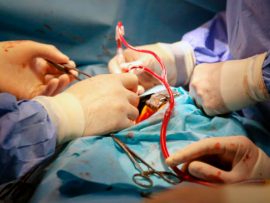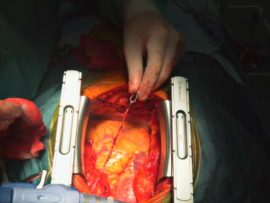Abstract Veno-arterial extracorporeal membrane oxygenation (ECMO) is a strong mechanical circulatory device for patients with hemodynamic deterioration due to cardiogenic shock, but its drawback is an increase in left ventricular..
Read MoreAbstract Different arterial cannulation strategies are feasible for veno-arterial extracorporeal membrane oxygenation (VA-ECMO) in postcardiotomy shock. We aimed to analyze potential benefits and safety of different arterial cannulation strategies. We..
Read MoreAbstract Extracorporeal life support (ECLS) can result in complications due to increased left ventricular (LV) afterload. The percutaneous ventricular assist device (PVAD) and intra-aortic balloon pump (IABP) are both considered..
Read MoreAbstract Weaning failure and mortality rates in veno-arterial extracorporeal membrane oxygenation (VA-ECMO) supported patients are significant. Small studies suggest the possible usefulness of levosimendan in this environment, especially in postcardiotomy..
Read MoreBackground Postcardiotomy cardiogenic shock (PCCS) refractory to inotropic support and intra-aortic balloon pump (IABP) occurs rarely but is almost universally fatal without mechanical circulatory support. In this systematic review and..
Read MoreBackground Post-cardiotomy cardiogenic shock (PCCS) has an incidence of 2–6 % after routine adult cardiac surgery. 0.5–1.5 % are refractory to inotropic and intra-aortic balloon pump (IABP) support. Advanced mechanical circulatory support..
Read MoreBackground Venoarterial extracorporeal membrane oxygenation (V-A ECMO) improves perfusion and oxygenation in patients with cardiogenic shock. However, it can also result in supranormal oxygen exposure. Recent evidence suggests hyperoxia may..
Read MoreAbstract Extracorporeal membrane oxygenation (ECMO) refers to specific mechanical devices used to temporarily support the failing heart and/or lung. Technological advances as well as growing collective knowledge and experience have..
Read MoreVenoarterial extracorporeal membrane oxygenation has emerged as a viable treatment for patients in cardiogenic shock with biventricular failure and pulmonary dysfunction. Advances in pump and oxygenator technology, cannulation strategies, patient selection and management, and durable mechanical circulatory support have..
Read MoreThe use of veno-arterial extracorporeal membrane oxygenation (VA-ECMO) as a salvage therapy in cardiogenic shock is becoming of current practice. While VA-ECMO is potentially a life-saving technique, results are sometimes mitigated, emphasising the need for selecting..
Read MoreAbstract Background Cardiogenic shock is the main cause of death in hospitalized patients with acute coronary syndromes, with a high mortality rate. The management of graft thrombosis after coronary artery..
Read MoreAbstract Aims Percutaneous veno‐arterial extracorporeal membrane oxygenation (VA‐ECMO) is utilized for patients with cardiogenic shock or cardiac arrest. However, the procedure protocol for weaning from VA‐ECMO has not been well..
Read MoreAbstract OBJECTIVES Left-sided unloading during extracorporeal membrane oxygenation (ECMO) therapy is crucial to prevent pulmonary oedema and facilitate ventricular recovery. We present the case of a 55-year-old man under ECMO..
Read MoreAbstract Postcardiotomy cardiogenic shock (PCCS) is a rare but catastrophic syndrome that can occur following separation from cardiopulmonary bypass or at any time during the immediate postoperative course. The management..
Read MoreAbstract Extracorporeal membrane oxygenation (ECMO) has been used increasingly for both respiratory and cardiac failure in adult patients. Indications for ECMO use in cardiac failure include severe refractory cardiogenic shock,..
Read MoreAbstract Introduction: Prophylactic intra-aortic balloon counterpulsation (pIABC) is recommended for high-risk patients undergoing coronary artery bypass grafting (CABG) surgery. Criteria for high-risk patients benefiting from pIABC are unclear. This study..
Read MoreAbstract Vasoplegia is a ubiquitous phenomenon in all advanced shock states, including septic, cardiogenic, hemorrhagic, and anaphylactic shock. Its pathophysiology is complex, involving various mechanisms in vascular smooth muscle cells..
Read MoreAbstract Background The role of inflammation in patients with coronary artery disease is emerging. We sought to assess the profile and outcomes of patients with a clinical syndrome of severe systemic..
Read MoreAbstract Background Extracorporeal membrane oxygenation (ECMO) is increasingly used in resuscitation of critically ill patients with documented improved survival. Few studies describe ECMO use in cardiogenic shock. This study examines..
Read MoreAbstract OBJECTIVES Post-cardiotomy cardiogenic shock (PCCS) results in substantial morbidity and mortality, whereas refractory cases require mechanical circulatory support (MCS). The aim of the study was to compare extracorporeal membrane..
Read MoreAbstract Veno-arterial extracorporeal membrane oxygenation (VA ECMO) is widely used in cardiogenic shock. It provides systemic perfusion, but left ventricular (LV) unloading is suboptimal. Using a closed-loop, real-time computer model..
Read MoreAbstract Introduction: The acute surgical treatment of infective endocarditis (IE) carries a high risk of postoperative mortality. Most complications are linked to uncontrolled sepsis and inflammatory processes. Cytokine haemoadsorption is..
Read MoreAbstract Purpose of review Intraaortic balloon pump (IABP) has been the most widely used device to help patients recover from circulatory disorder mainly because of cardiogenic shock; however, no evidence-based..
Read MoreSummary (CS) is a major challenge in contemporary cardiology. Despite a better understanding of the of CS, its management has only improved slightly. The prevalence of CS has remained stable over..
Read MoreAbstract Temporary mechanical circulatory support (TCS) is recommended for patients with profound cardiogenic shock (CS). Extracorporeal membrane oxygenation (ECMO) and Impella are possible TCS devices, but the device choice and the implantation..
Read MoreAbstract Venoarterial extracorporeal membrane oxygenation (VA-ECMO) has been used for refractory cardiogenic shock; however, it is associated with increased left ventricular afterload. Outcomes associated with the combination of a percutaneous..
Read MoreAbstract The objective of this study is to establish reliable markers for mortality in children with refractory cardiogenic shock who underwent extracorporeal membrane oxygenation. A retrospective observational cohort study was..
Read MoreAbstract Central venoarterial extracorporeal membrane oxygenation has been used since the 1970s to support patients with cardiogenic shock following cardiac surgery. Despite this, in-hospital mortality is still high, and although..
Read MoreAbstract Background and Aim of the Study Extracorporeal life support (ECLS) may be necessary in refractory postcardiotomy cardiogenic shock (PCS) unresponsive to optimal medical treatment. We sought to analyze the..
Read MoreAbstract Background: Renal failure is a common occurrence in patients with refractory cardiogenic shock including those supported with veno-arterial extracorporeal membrane oxygenation. Prevalence and outcome of acute and chronic kidney..
Read More













